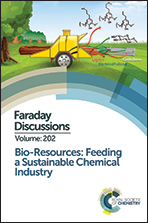Bioelectrochemical conversion of CO2 to chemicals: CO2 as a next generation feedstock for electricity-driven bioproduction in batch and continuous modes
Abstract
The recent concept of microbial electrosynthesis (MES) has evolved as an electricity-driven production technology for chemicals from low-value carbon dioxide (CO2) using micro-organisms as biocatalysts. MES from CO2 comprises bioelectrochemical reduction of CO2 to multi-carbon organic compounds using the reducing equivalents produced at the electrically-polarized cathode. The use of CO2 as a feedstock for chemicals is gaining much attention, since CO2 is abundantly available and its use is independent of the food supply chain. MES based on CO2 reduction produces acetate as a primary product. In order to elucidate the performance of the bioelectrochemical CO2 reduction process using different operation modes (batch vs. continuous), an investigation was carried out using a MES system with a flow-through biocathode supplied with 20 : 80 (v/v) or 80 : 20 (v/v) CO2 : N2 gas. The highest acetate production rate of 149 mg L−1 d−1 was observed with a 3.1 V applied cell-voltage under batch mode. While running in continuous mode, high acetate production was achieved with a maximum rate of 100 mg L−1 d−1. In the continuous mode, the acetate production was not sustained over long-term operation, likely due to insufficient microbial biocatalyst retention within the biocathode compartment (i.e. suspended micro-organisms were washed out of the system). Restarting batch mode operations resulted in a renewed production of acetate. This showed an apparent domination of suspended biocatalysts over the attached (biofilm forming) biocatalysts. Long term CO2 reduction at the biocathode resulted in the accumulation of acetate, and more reduced compounds like ethanol and butyrate were also formed. Improvements in the production rate and different biomass retention strategies (e.g. selecting for biofilm forming micro-organisms) should be investigated to enable continuous biochemical production from CO2 using MES. Certainly, other process optimizations will be required to establish MES as an innovative sustainable technology for manufacturing biochemicals from CO2 as a next generation feedstock.
- This article is part of the themed collection: Bio-resources: feeding a sustainable chemical industry


 Please wait while we load your content...
Please wait while we load your content...